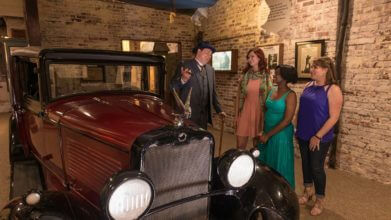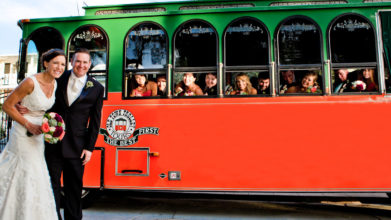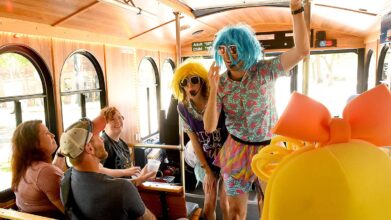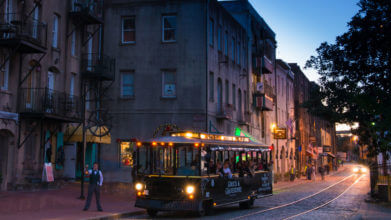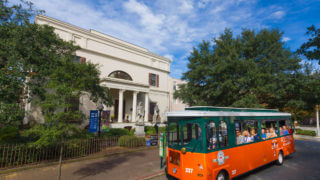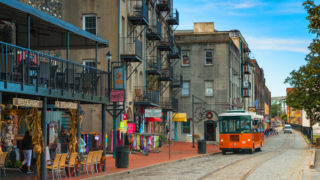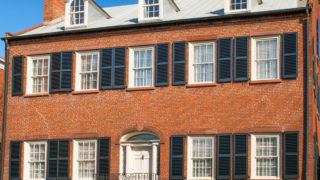Savannah Historic Homes In Madison Square
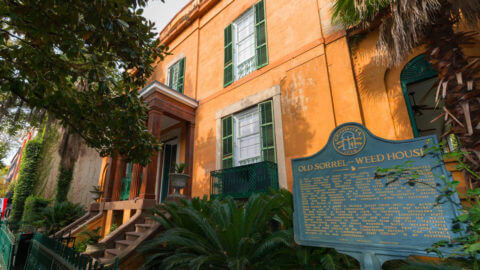
Savannah is known for its beautifully preserved historic homes. Each home has its own story, offering a glimpse into the city’s past through architecture, art, and the lives of the people who lived there. Many of these homes have been turned into museums, allowing visitors to learn about Savannah’s growth, culture, and community. Exploring Savannah historic homes is one of the best ways to connect with the city’s history and understand how its neighborhoods came to life. Walking through these elegant structures allows visitors to see firsthand the craftsmanship and design that defined the 19th and early 20th centuries. The preservation of these homes also showcases Savannah’s dedication to protecting its unique identity for future generations.
Owens-Thomas House & Slave Quarters
Constructed in 1819 and designed by Architect William Jay, the Owens-Thomas House is a standout among all Savannah historic homes. Its graceful English Regency architecture, curved walls, and ornamental details are beautiful examples of the style. But the site is also home to something even more meaningful. The preserved urban slave quarters on the property offer an important and respectful look into the lives of the enslaved people who lived and worked here. Visitors can view original structures, artifacts and carefully curated exhibits that explain their daily experiences and contributions to the household and the city. Through thoughtful interpretation and guided tours, guests learn how the work of enslaved people impacted not only this home but the broader economy of early Savannah. Touring this home brings balance to Savannah’s story, honoring both the beauty of the architecture and the complex human histories that shaped it. The Owens-Thomas House remains one of the most significant historic homes in Savannah, offering an educational and thought-provoking experience.
Mercer Williams House Museum
The Mercer-Williams House, completed in 1868, is one of the most recognizable historic homes in Savannah. The Italianate design features grand rooms, ornate woodwork, and large windows that fill the space with light. Visitors are drawn here not only for its beauty but also for its connection to Midnight in the Garden of Good and Evil, the book that made Savannah famous around the world. The home’s last private owner, Jim Williams, was a passionate preservationist who worked to protect many historic homes in Savannah and played a major role in the city’s restoration movement. Today, tours of this home let visitors admire the stunning architecture, learn about the people who lived here, and hear stories of the house’s place in Savannah’s cultural and preservation history. The blend of literature, history, and design makes this home a must-see for anyone interested in exploring Savannah historic homes.
Sorrel Weed House
Among the largest historic homes in Savannah, the Sorrel Weed House is impossible to miss. Built in 1840, this mansion blends Greek Revival and Regency styles with towering columns, grand staircases and intricate ironwork. Originally the home of Francis Sorrel, a successful merchant, the property has a long and colorful past. Rooms are furnished with period-appropriate decor, and the architecture itself is a showcase of mid-19th-century craftsmanship. The house is also known for ghost stories that have been told for generations, adding an air of mystery to its already impressive reputation. In addition to architectural tours, the Sorrel Weed House offers evening ghost tours that highlight its mysterious history and unexplained occurrences reported by visitors and staff alike. For guests who appreciate both historical detail and local legend, this property remains one of the most fascinating historic homes in Savannah.
Juliette Gordon Low Birthplace
The birthplace of Juliette Gordon Low, founder of the Girl Scouts of the USA, is both beautiful and inspiring. Built in 1821, this Regency-style mansion has been lovingly restored to reflect the elegance of the Victorian era. Visitors can see original family furnishings, period clothing and artwork that helps tell the story of Juliette’s life. Exhibits celebrate her contributions to empowering young women and highlight how the Girl Scouts have grown into a global organization. The home also showcases her artwork and letters, offering insight into her creativity and vision. Touring this house gives visitors a close look at one of the most influential figures in American history. The house’s location in the heart of the historic district makes it easily accessible for visitors seeking to learn more about the city’s cultural impact. This museum remains one of the most treasured Savannah historic homes, offering both historical depth and personal stories that resonate with visitors of all ages.
Andrew Low House
The Andrew Low House, built in 1848, stands as a classic example of Italianate architecture. This stately home belonged to Andrew Low, a successful Scottish merchant who made Savannah his home. The property’s ornate iron balconies, richly decorated parlors and manicured gardens reflect both elegance and hospitality. Later, it became the residence of Juliette Gordon Low, adding even more significance to its story. Today, guided tours of this historic home in Savannah share the family’s legacy and the role this home played in shaping Savannah’s cultural landscape.
Davenport House Museum
The Davenport House Museum, built in 1820, has become a symbol of Savannah’s dedication to preservation. Designed by master builder Isaiah Davenport, this Federal-style brick home features beautiful woodwork, antique furnishings, and period decor that bring early Savannah to life. The home was nearly lost in the 1950s but became the first property saved by the Historic Savannah Foundation, sparking the city’s preservation movement. Tours show visitors’ lives in the early 1800s and explain how saving this house inspired efforts to protect other Savannah historic homes.
Green-Meldrim House
The Green-Meldrim House is one of the most significant Savannah historic homes, known for its striking Gothic Revival design. Built in the 1850s for Charles Green, a successful cotton merchant, the home features arched windows, elaborate ironwork, and detailed wood carvings. During the Civil War, General William T. Sherman made this house his headquarters after arriving in Savannah. Visitors touring this historic home in Savannah can explore rooms filled with original furnishings and hear stories about the city’s surrender and the telegram sent from these very walls to President Lincoln. Guides also highlight how the home became a place of refuge and strategy during a turning point in American history. Its carefully preserved architecture and pivotal role in Savannah’s past make it a must-see for anyone interested in Savannah historic homes.
Harper Fowlkes House
The Harper Fowlkes House stands as one of the most beautifully maintained historic homes in Savannah. Built in 1842, the house reflects the grandeur of Greek Revival architecture, with soaring columns, intricate plasterwork and sweeping verandas. Alida Harper Fowlkes, an influential preservationist, purchased and restored the property, ensuring that the home’s legacy would endure. Inside, visitors will find period furnishings, fine art, and a collection of decorative pieces that reflect Savannah’s cultural and social history. Each room tells part of the story of the families who lived here and the city’s preservation movement. Today, this Savannah historic home also serves as the headquarters for the Georgia Society of the Cincinnati, adding historical depth to its purpose. For those exploring historic homes in Savannah, this elegant house offers a glimpse into 19th-century life paired with 20th-century preservation efforts.
Flannery O’Connor Childhood Home
Nestled on Lafayette Square, the Flannery O’Connor Childhood Home is a special stop for those exploring Savannah historic homes. This restored 19th-century residence offers visitors a look into the formative years of one of America’s most acclaimed Southern authors. The home features personal items, early manuscripts, and exhibits that explore how Savannah’s unique culture and traditions influenced O’Connor’s writing. Knowledgeable guides share stories about her childhood and the neighborhood that shaped her voice. The house regularly hosts literary events and readings, making it not only a museum but an active part of the city’s cultural landscape. Among all the historic homes in Savannah, this one stands out for its connection to literature and its dedication to keeping O’Connor’s legacy alive for new generations of readers.
Closing
Visiting Savannah historic homes offers more than just a glimpse of beautiful architecture. It provides a chance to connect with the stories, achievements and challenges of the people who shaped the city’s history. Each residence is carefully preserved to highlight its unique style, from grand columns and detailed ironwork to handcrafted woodwork and historic furnishings. Exploring these historic homes in Savannah allows visitors to understand the city’s evolution, from its early days as a colonial settlement to its role in pivotal moments like the Civil War and the preservation movement that followed. Many of these homes open their doors for guided tours, allowing guests to walk through elegant parlors, private gardens and historically significant rooms while learning about Savannah’s cultural legacy. For anyone planning a visit, these Savannah historic homes are an essential part of experiencing the city’s charm and history firsthand.
FAQs
What is the most famous historic home in Savannah?
While several Savannah historic homes are well known, the Mercer Williams House Museum stands out as the most famous, largely due to its role in the book and film Midnight in the Garden of Good and Evil. Its captivating architecture and connection to Savannah’s modern literary and cultural history make it a must-see. Other significant homes include the Owens-Thomas House & Slave Quarters and the Juliette Gordon Low Birthplace, both offering deep insight into Savannah’s history and its people.
Can visitors tour these historic homes year-round?
Yes, most historic homes in Savannah offer guided tours throughout the year, showcasing both permanent exhibits and seasonal displays. Some homes host special holiday tours, candlelight evenings, or themed events that provide unique perspectives on life in different eras. Checking each site’s official calendar helps visitors plan for these special opportunities.
Are there any historic homes in Savannah associated with the Civil War?
The Green-Meldrim House is one of the most significant Savannah historic homes connected to the Civil War, serving as General William T. Sherman’s headquarters during the Union occupation. Additionally, several other homes include period displays and stories highlighting the war’s impact on the families who lived there and the city as a whole.
Which historic homes offer ghost tours in Savannah?
The Sorrel Weed House is one of the most prominent historic homes in Savannah known for its ghost tours, and is frequently cited as one of the most haunted locations in the country. Other homes, like the Davenport House Museum, also have seasonal ghost tours that blend local folklore with real historical accounts.
Can you visit these homes without booking a tour in advance?
Some Savannah historic homes allow walk-in visitors, but advanced reservations are strongly encouraged, especially during holidays or festivals, when tours often sell out. Booking ahead ensures visitors can secure preferred times and participate in specialty tours, such as architecture-focused or behind-the-scenes experiences.
Are any of these historic homes part of local festivals or special events?
Many historic homes in Savannah are featured in the annual Savannah Tour of Homes & Gardens, offering rare access to private residences and beautifully restored interiors. Visitors can also experience these homes as part of special holiday tours and seasonal events. For those looking for an easy way to explore multiple historic sites, Old Town Trolley Tours® provides a convenient and fully narrated way to visit some of Savannah’s most iconic homes and learn about their place in the city’s history.

